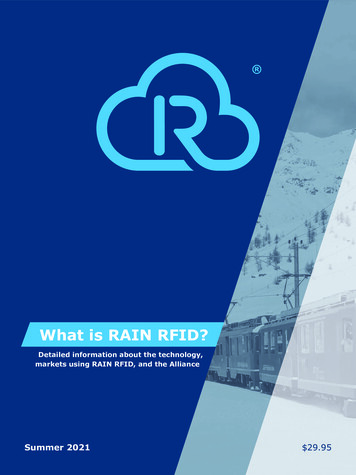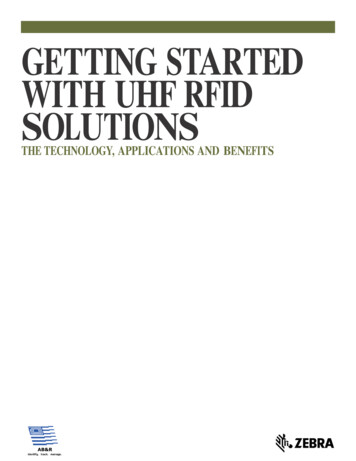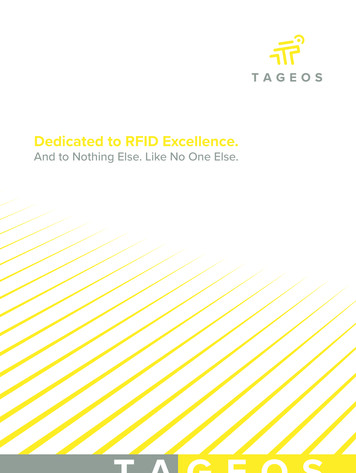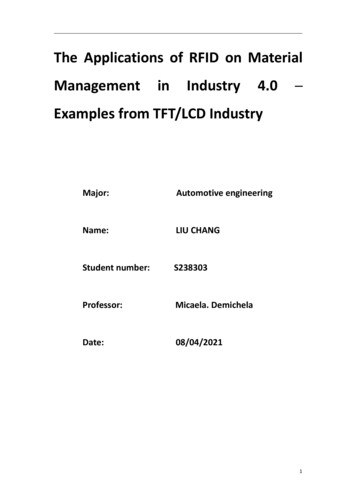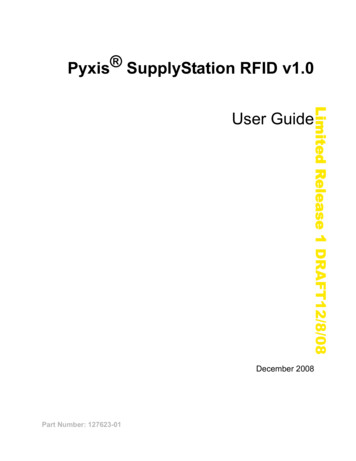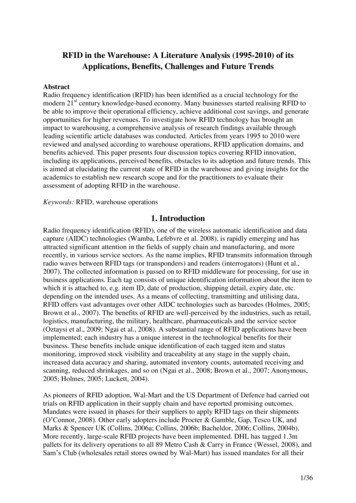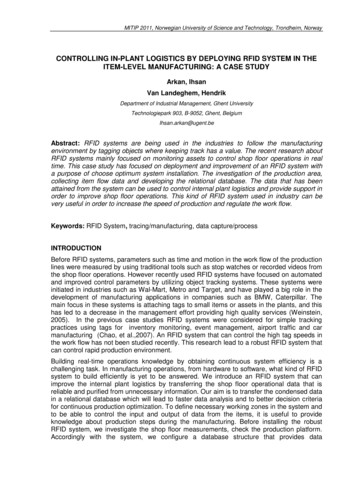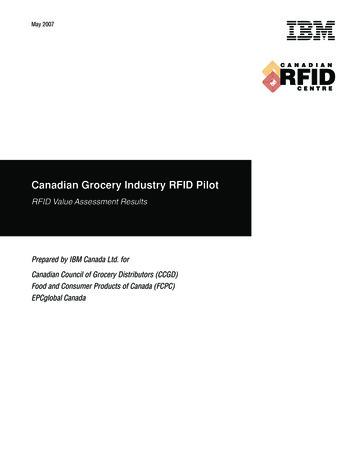
Transcription
May 2007Canadian Grocery Industry RFID PilotRFID Value Assessment ResultsPrepared by IBM Canada Ltd. forCanadian Council of Grocery Distributors (CCGD)Food and Consumer Products of Canada (FCPC)EPCglobal Canada
RFID Value Assessment ResultsPage 2ContentsExecutive Summary3Pilot OverviewBackgroundObjectives, Execution, and DeliverablesTechnologyAnalysis Methodology88101112Pilot ResultsResults OverviewTechnology Key Messages141414Business Case DriversBenefits OverviewInvestments181826Deployment StrategyDeployment Overview3030Next Steps34
RFID Value Assessment ResultsPage 3Executive SummaryHighlights“The Canadian grocery industry RFID pilotwas done for the right reasons, the rightPreparing for the future of RFIDThe Canadian RFID Grocery Industry Pilot was born out of the collaborativepartnership between the key players associated with the Canadian RFID Centreway and provides members with the rightinformation to understand the conditionsthat will be required for successful implementof RFID throughout the grocery supply chain.(CRC): industry, associations and technology providers. Four grocery productmanufacturers, one retailer, three industry associations and three RFID solutionproviders participated in the Pilot, which was conducted under the premise thatRFID and EPC adoption should be approached as an industry-wide initiative.The commitment of the industry to takea collaborative approach to understandRFID’s potential and the impact and benefitsto both suppliers and retailers is unique tothe Canadian market and defines our industryapproach to changes that require criticalmass adoption to maximize benefits.”- David Wilkes, Senior Vice President,Trade and Business Development,Canadian Council of Grocery DistributorsWith a focus on the business case validation of food traceability, distribution centreefficiencies, environmental monitoring and reduction of out-of-stocks at the retaillevel, the Pilot took place between May 2006 and January 2007. To analyze the Pilotresults, our detailed methodology covered: analysis of the product flow dynamics; benefits identification and quantification; investments assessment; and business case development for each manufacturer and retailer involved.“The Canadian RFID Centre and the RFIDIndustry pilot are excellent examples of theindustry working collaboratively to ensuredue diligence on emerging issues thatcan significantly affect the supply chain.In the case of RFID, building knowledgeand examining the business case collectivelyprovides stakeholders with an objectiveperspective that can be used to makedecisions.”- Elaine Smith,Senior Vice President, Industry AffairsFood and Consumer Products of CanadaThis White Paper examines the results of the Grocery Industry RFID Pilot andsuggests recommendations for industry adoption. As RFID gains traction in theCanadian market, the question of RFID adoption in Canada’s grocery industryis not a matter of “if”, but rather, “when.” Early – and informed – adoption is keyto successful implementation.
RFID Value Assessment ResultsPage 4Results OverviewEven though the Pilot had a unique, collaborative industry-wide approach,it confirmed some findings identified in other previous studies. When consideringRFID, it is important to delve deeply into an organization.Read rates improved significantly over the course of the Pilot, rising an averageof 18% overall. By using “inference of read rates” companies can achieve benefitsin various categories, including traceability, promotions management, conditionmonitoring, out of stock and improved labour efficiencies. In addition, new andupgraded technology can contribute to improved read rates and thus improvedresults. Effectiveness can be maximized by integrating the RFID solution datainto existing applications for improved decision-making.From a retailer perspective, RFID provides a positive return given critical massof tagged cases and pallets is achieved through the distribution and store network.On the manufacturer’s side, the results were mixed. Payback for this pilot study washighly dependent on how manufacturers were currently performing in the six benefitareas analyzed. If manufacturers were performing very efficiently in certain areas,or they had difficulty quantifying their existing environment, potential improvementopportunities were harder to identify and track. It should also be noted that paybackwas very sensitive to changes in the labour required to tag cases and hardware costs.With Slap and Ship, RFID benefits are only considered after the tagged productleaves the manufacturer’s DC. Therefore, it does not represent the full potentialRFID can offer to a manufacturer.Other potential benefits derived from additional information and inventory visibilityto support other business areas – such as demand forecasting, production, inventorymanagement and marketing – have not been quantified and included in the businesscase. The business cases also exclude benefits that could be realized in other supplychain execution areas such as transportation management, asset tracking and rawmaterials and work-in-process inventory management. Such areas were not in scopeof analysis in the Pilot.
RFID Value Assessment ResultsPage 5Some of the results were surprising. Given the current high level of effectivenessin managing shipments from suppliers to retailers, only limited Proof of Deliverybenefits were quantified. These results, however, may not reflect the reality ofthe industry, particularly for those companies with very fragmented distributionnetworks that see the standardization of their processes as a challenge. For thosecompanies, RFID could provide drastic gains by automating their shipping andreceiving.For traceability, benefits depended greatly on each pilot participants own supplychain network and were mainly qualitative in nature. That’s because the real valueof traceability information is serving as a source of feedback to support pro-activerisk mitigation measures that will drive efficiency gains and optimize logistics,manufacturing and quality management processes.Using RFID SuccessfullyThe greatest benefits discovered in the Pilot related to improving promotionexecution and reducing out of stocks. These benefits categories provided substantialpotential, but are highly dependent on the interaction among members in thesupply chain. Therefore, the benefits realization can be compromised by lack ofcollaboration between retailers and manufacturers in terms of information sharingand process execution.Critical to any successful RFID deployment is a collaborative effort – the sharing ofinformation between manufacturer and retailer to realize mutual benefits associatedwith promotion management and out-of-stocks at the retail store.
RFID Value Assessment ResultsPage 6The Pilot showed that: “Slap and Ship” can be a workable approach, if used in a low-volumesituation where there is no benefit in investing in a larger solution. Regardless,it was discovered that the earlier the tag was applied in the supply chain, thebetter the result in terms of improved accuracy and more efficient shipping. RFID can be used to avoid OOS situations. RFID delivers real-time informationabout inventory levels in the supply chain, enabling employees to act uponthat information. Thus, operational variability can be reduced and productavailability at the stores can be improved. RFID technology is expected to offer a superior level of promotions managementdue to the enhanced visibility both retailers and manufacturers gain oninventory positions, before and during the promotions. RFID is also promisingimproved traceability during a recall because managers can have full visibilityinto where the products are moving from the moment they have a commis sioned RFID tag attached to them until they are available to consumers. RFID can improve the effectiveness of shipping and receiving processes.It enables operators to proactively identify wrong picks, short shipmentsand overages before loading is concluded.Cost ConsiderationsThe most cost-effective solution for each client was chosen, and the range of costsis illustrated in the following table for all participants in the Pilot.Investment AreaLower Range %of total costsHigher Range %of total costsCorporate Services616Application & s333
RFID Value Assessment ResultsPage 7Explanation of costs: Corporate Services: All consulting and internal manpower requiredfor an RFID solution. Application and Integration: Application hardware, middleware and coststo integrate RFID application into existing WMS systems. Maintenance: Yearly software maintenance and support. Hardware: RFID readers and tagging equipment Labour: Labour required tagging cases and pallets Tags: individual costs of an RFID tagTailoring RFID for your business needsGiven the findings of the Pilot, a compelling case exists from a retailer’s perspectiveto deploy RFID. From a manufacturer’s perspective, the case is not as clear cut.Preparation of a full business case is required to see where a particular manufacturerstands. Depending on their specific pain points, deployment of RFID by productor product category may be a viable option.
RFID Value Assessment ResultsPage 8Pilot OverviewHighlightsThe Canadian RFID Grocery Industry Pilotwas conducted under the premise that RFIDand EPC adoption should be approached asan industry-wide initiative. This White Paperreports the findings and conclusionsfrom the Pilot and suggests a series ofrecommendations for industry adoption.Background and ScopeThe Canadian RFID Grocery Industry Pilot (the “Pilot”) was launched as a logicalextension to the collaborative partnership created at the Canadian RFID Centre(CRC) between industry, associations and technology providers. This Pilot wasconducted under the premise that RFID and Electronic Product Code (EPC)adoption should be approached as an industry-wide initiative. All the participantsidentified herein have contributed significantly to this project and its findings.The purpose of this White Paper is to report the findings and conclusions fromthe Pilot and to suggest a series of recommendations for industry adoption.Four grocery product manufacturers, one retailer, three industry associationsand three RFID solution providers were involved in the pilot.The industry participants were: General Mills Canada Loblaw Companies Limited Maple Leaf Foods Kruger Products Limited Unilever CanadaThe industry associations were: Canadian Council of Grocery Distributors (CCGD) Food & Consumer Products of Canada (FCPC) EPCglobal CanadaThe solution providers were: IBM Canada Ltd. Intermec Technologies Limited Motorola, Inc. (formally Symbol Technologies Limited)
RFID Value Assessment ResultsPage 9Unless otherwise stated, the results (including findings and recommendations)outlined in this paper are based on the scope in which the Pilot was executed.Each of the four suppliers tagged two to three SKUs at the case and pallet level forthe Pilot. In total, 10 SKUs were tagged. The tagged SKUs were shipped to a singleretailer distribution centre and then sent to be sold at two retail stores. The selectedproducts spanned a wide range of categories, encompassing frozen products,refrigerated products and dry goods. They included: Dry products Canned products Fresh, processed meat products Frozen products Display-ready palletsDuring the life cycle of the products, they were read by fixed RFID portals at thetime of: manufacturer shipping; retail distribution centre receiving; retail distributioncentre shipping; retail store receiving; upon entry or return from the retail storesales floor; and finally, when entered into the retail store trash compactor.The following were specific to each location:Supplier Warehouse: The supplier warehouse or third party logistics (3PL) entity,which provided RFID and EPC enablement services on the supplier’s behalf, storedgoods for shipment to customers. The key technology consideration for the sup plier was the entry point and conversion of products with UPC SKUs into the EPCstandard, and the departure of EPC enabled goods to other locations of the supplychain.
RFID Value Assessment ResultsPage 10Distribution Centre (DC): The distribution centre was used to store goods frommultiple suppliers, and to fulfill orders of required goods for the two retail stores.The distribution centre infrastructure allowed RFID enabled product to be trackedas they entered and left the distribution centre. The key points of interest in thedistribution centre included receiving and shipping docks, as well as storage(freezer, fridge, dry goods).Retail Store: The retail domain consisted of the back end, receiving area of a retailstore where shipments were received from the retailer’s distribution centre,the entry point to the store floor where goods were displayed for sale, and thetrash compactor where the boxes and wrappers were disposed.Objectives, Execution and DeliverablesThe primary objectives for the Canadian Food Industry RFID Pilot included:1) Validation of the RFID business case associated with food traceability, distributioncentre efficiencies, environmental monitoring (temperature) and reductionof out-of-stock at the retail level2) Creation of an industry implementation approach for each supplier,distributor and retailer3) Validation of the findings made at the Canadian RFID Centre (CRC) in the fieldTo accomplish these objectives, the project was organized into five distinct phases,beginning in May 2006 and ending in January 2007.Phase 1Phase 2Phase 3Phase 4Phase 5ProjectMobilization& SolutionDesignSolution Build& SiteMobilizationSolution Install& Solution TestPilot Launch &Pilot RunResult Analysis& ReportDevelopmentMay 1 - June 6June 6 - July 6July 7 - July 28 July 28 November 3November 4 January 15
RFID Value Assessment ResultsPage 11TechnologyThe Pilot was conducted using a centralized hosted applications model; therefore,limited technology was physically deployed at each of the participating sites. Thisapproach was used because it provided: Speed to deployment; Lower costs for participants; Easier management and support during Pilot execution; and A scalable solution, capable of being reused in a future deployment.
RFID Value Assessment ResultsPage 12Analysis MethodologyA detailed methodology was applied to analyze the Pilot results. The methodologycovered not only analysis of the product flow dynamics during the Pilot, but alsobenefits identification and quantification, investments assessment and businesscase development for each manufacturer and retailer involved.Business processes that were impacted by the rollout of an RFID solution wereinvestigated. The business processes were then used to define a set of benefitcategories for analysis. In addition, several discussion points were prepared forthe respective benefits. A questionnaire was completed to summarize baselinedata for each Pilot participant.The benefits were quantified at a per-case level, to take into account differentvolume flows throughout each participant’s supply chain. Along with the potentialbenefits calculation, real illustrations of how business can capture value providedby RFID solutions were identified as a result of Pilot observations. Examples wereshown throughout the Pilot with the aid of information provided by an RFIDsolution. These included proof of delivery (discrepancies treatment, service levelimprovement, returns), traceability (old code / spoilage, order tracking, recalls),condition monitoring, inventory visibility, out-of-stock, promotions managementand labour efficiencies.Market pricing from the software and hardware vendors involved were utilizedas a baseline for the investments calculations. Using information from participants,a customized, cost-effective RFID solution was conceived for each participant.A yearly deployment strategy was then developed to obtain the best net financialoutcome for all the participants involved in the Pilot to supply one retailer.The number of cases requiring RFID tags on a yearly basis was used for eachparticipant and hardware investments were extrapolated accordingly to handlethe flow of RFID tagged cases. Specific assumptions were made around the pricedepreciation of RFID equipment and future trends (i.e. tag prices). Some of thekey assumptions used when calculating payback were a 0.10 tag cost depreciatingto a floor of 0.05 and hardware discounts based on large orders. Finally extensivesensitivities were conducted on these variables to assess the level of impact.
RFID Value Assessment ResultsPage 13Four Investment ModelsFrom an investment perspective, four distinct investment models were evaluatedfor each manufacturer: Slap and Ship, Hybrid, Inline Printing, and Corrugate Tagging.Each model was considered for the manufacturers and the best viable solution wasanalyzed in detail for them to provide an RFID solution to one retailer.Slap and Ship: This model was used during the Pilot project and requires allsuppliers’ products to be manually tagged at their manufacturing sites or distributioncentres. This model provides the least required capital investment but allowscompanies to provide an RFID solution to comply to any potential mandate withsignificant impact to their current processes. However, because labour costs riseas case volumes increase, it is not recommended as a long-term solution.Hybrid: This model is a “slap and ship” model in early deployment years (whenvolumes are low), and a “print and apply” automated system in the later, high-volumeyears. Some additional manual labour is still required. This model proves that taggingmay be done at a 3PL or within the manufacturing/distribution network of thesuppliers. The Hybrid model provides the smallest investment for a large manufacturerwho still needs to provide an RFID and non-RFID solution to its customers.Inline Printing: All cases are tagged by an inline printer installed on each of themanufacturer’s product lines. This model provides the best long-term solution formanufacturers/suppliers in terms of reducing the labour costs and inefficiencies.It affords the best opportunity to capitalize on additional benefits that can be gainedupstream in internal warehousing, inventory control and logistics. The challengehere is twofold: 1) Segregating RFID orders from non-RFID orders is difficult, and2) Many manufacturers have a global supply chain and would require an internationalRFID initiative to make inline printing a practical and cost-effective solution.Corrugate Tagging: This final model considers RFID tags embedded into the casecorrugate by the corrugate suppliers. This option, like inline printing, is deemed tobe a viable long term solution. However, the viability of the corrugate tagging modelstrongly depends on the technology maturing and its broader adoption by othermembers of the supply chain. Corrugate suppliers should understand that productswith RFID labels can be considered a distinct line of business, and as such, mightdrive substantial business opportunities.
RFID Value Assessment ResultsPage 14Pilot ResultsHighlightsIntegrating the RFID solution data intoexisting operational and decision-makingapplications will align the use of theinformation with day-to-day activities.Results OverviewResults clearly showed that read rates improved significantly over the courseof the Pilot, rising an average of 18%. At the same time, it was evident that byusing “inference of read rates” companies can achieve benefits in various categories,including traceability, promotions management, condition monitoring, out of stockand improved labour efficiencies. New and upgraded technology can contribute toimproved read rates and the benefits realized. And finally, the effectiveness ofthe solution can be maximized by integrating the RFID solution data into existingapplications for improved decision-making.Technology Key MessagesRead rate performance promises significant business value across the supply chainRead rates improved significantly over the course of the Pilot. The initial averageread rate for the nine piloted SKUs was 71%. However, by the end of the Pilot,the average read rate had risen to 89%. This 18 percentage point improvementcan be attributed to modifications and adjustments to the process, equipment andapplication including upgrading the firmware and middleware. In addition, propertag placement on the product was critical to achieving the optimal read rate.Even more significantly, three out of the nine SKUs had 100% read rates and sevenout of the nine SKUs had read rates over 85%. The results of the Pilot show thatfor many product categories and packaging types, RFID read rate performance isadequate today to drive significant business value across the supply chain. However,there are others for which further read rate improvements are still required beforethere is a rationale for adoption.It is important to note that this Pilot did not consider the process changes or thebusiness reengineering of pallet configurations; therefore, the read rates experiencedin this Pilot could have been higher had these changes been considered. Thisreport cannot make recommendations on pallet reconfiguration – each companyneeds to evaluate the implications of making such changes to their business.
RFID Value Assessment ResultsPage 15Ultimately, given ongoing technology improvements, read rates are expected tocontinue to rise. Ongoing testing of new technology such as tags and readers willfurther improve read rates, bringing RFID a step closer to full adoption.Inference of read rates often sufficient to drive business benefitsIn situations where a 100% read rate is currently not achievable, the conceptof “inferring a read” may be applicable. Read rate inference utilizes the knownnumber of case tags associated with a pallet. During pallet building, RFID tagsare printed and commissioned. The number of case tags along with tag EPCsare then associated with a specific pallet tag. Those tags are applied to the casesand pallet, and a baseline or aggregation is performed.Therefore, at the next read point, if only 85% of the case tags are read, the other15% are inferred or read based on the known fact they are associated with thatpallet. If at any instance in the supply chain the pallet is broken down, and baselineor aggregation is established, case tags are then associated to the pallet tag for thenewly created pallet.Inference of read rates will allow a company to achieve benefits – where achievinga 100% read rate is currently not available – in various categories, includingtraceability, promotions management, condition monitoring, out of stockand improved labour efficiencies.Retailers will often use the concept of Trusted Supplier Agreements with theirvendors and regularly audit receipts from vendors to ensure that case quantitiesassociated with pallets are accurate. In this way, when there is a high degree of trustbetween the retailer and its vendors in terms of ship/receive quantities, inferenceof read rates is an acceptable RFID practice.
RFID Value Assessment ResultsPage 16As RFID technology improves, companies must continue to assess its benefitsAs demonstrated during the Pilot, upgrades to existing technology components,along with the introduction of new technology, contributed to the improvementof read rates and the overall efficiency of the technology. This allows for moreoptions when designing and implementing an RFID solution; they improvethe read rates of products with challenging compositions.Companies must continue to monitor and evaluate RFID technology. Technologyassessed at the beginning of a deployment will improve within a short time frame,and applying the most efficient technology components will allow a companyto achieve the most from its RFID strategy. For example, during the three monthsof the Pilot, we observed an improvement in all aspects of the technology: readers,firmware, software, and middleware.Integration of RFID technology with existing decision-making tools will improve benefitsIntegrating the RFID solution tool sets and data into existing operational anddecision-making applications will align the use of the information with day-to-dayactivities.Most sophisticated replenishment, inventory management, manufacturingand warehouse management systems drive the planning and operational activities– and subsequent feedback – into the financial aspect of the organization.Point-of-sale information is typically integrated into back-office solutionsperiodically throughout the day.However, the speed and quantity of data flowing from an RFID solution – dynamicallyintegrated with the operational and decision-making tools – can expedite theaction/reaction time significantly. Triggering management or operational alertsto situations such as out-of-stocks, code date issues, stocking, picking or shippingerrors, will only be beneficial if that information is provided real-time to the userwho must remedy the situation. This changes the landscape of reaction and execution,to event-driven activities that need to be performed by floor staff in the retail store,warehouse or manufacturing environments. The key is having the information receivedby the right person at the right time, giving them the opportunity to correct oraddress the situation.
RFID Value Assessment ResultsPage 17Information available to the manufacturer, such as inventory status and sales trends,can increase the accuracy of production volumes and capacity requirements froma planning and production perspective when integrated into planning and forecastingmodules. This can reduce the reliance on forecasting methods that are typicallyused today – which are “best-guesses” based on historical information insteadof real-time data. This is not to say that these methods will become obsolete,but they can be enhanced by the influx of current data and information.The level and timing of integration should be tempered with maximizing thebenefits. Integration into complex systems can be a long and expensive endeavor.Integration of the RFID data into business and operational systems through detailplanning, design, development and deployment should be an activity that isperformed in the initial phases of an RFID deployment plan.
RFID Value Assessment ResultsPage 18Business Case DriversHighlightsReducing out-of-stock (OOS) levels representsthe greatest opportunity area for both retailersBenefits OverviewThe Pilot demonstrated that RFID can be used to avoid OOS situations. RFIDdelivers real-time information about inventory levels in the supply chain, enablingand manufacturers to profit from RFIDtechnology adoption.employees to act upon that information. Thus, operational variability can bereduced and product availability at the stores can be improved.It also showed that RFID technology is expected to offer a superior level of promotionsmanagement due to the enhanced visibility both retailers and manufacturers gainon inventory positions, before and during the promotions. RFID is also promisingimproved traceability during a recall because managers can have full visibility intowhere the products are moving from the moment they have a commissioned RFIDtag attached to them until they are available to consumers.Finally, RFID can improve the effectiveness of shipping and receiving processes.It enables operators to proactively identify wrong picks, short shipments andoverages before loading is concluded.Reduced out-of-stocks can be profitable for both manufacturers and retailersReducing out-of-stock (OOS) levels represents the greatest opportunity area forboth retailers and manufacturers to profit from RFID technology adoption. Eventhough several initiatives have been undertaken by the Consumer Package Goods(CPG) industry throughout the years to improve product availability on the shelves,OOS events still jeopardize brand loyalty, customer experience, and ultimatelyoverall profitability.Several factors can contribute to an out-of-stock situation. Unpredictable consumerbehavior, for instance, is a huge source of fluctuation in demand and can play a rolein reducing product availability. However, other causes of OOS are more dependenton process compliance and information-sharing infrastructure and, therefore,should have the full attention of both manufacturers and retailers.
RFID Value Assessment ResultsPage 19As illustrated in the chart, below, the following situation was identified duringthe Pilot: PoS data showed a period of five days in which there were 0 salesfor one of the Pilot products. RFID event data showed that in fact that particular product was in the backroom of the store during the time at which there was an out-of -stock at theshelf level. In a real-world implementation, the PoS activity would be linked to an alertmechanism which would notify store staff that there is an out of stock at theshelf and that the required product is located in the backroom.RFID can enable business analysts, category managers, merchandise managers and,ultimately, store personnel to act (and react) upon real-time information concerninginventory levels in different parts of the supply chain. As a result, a great part of theintrinsic operation variability can be reduced and, therefore, product availability atthe stores can be greatly enhanced. The table below describes some of the businessprocesses that can contribute to an OOS situation and how RFID can help minimizethem.
RFID Value Assessment ResultsPage 20How RFID can address OOSAreasOrdinary ProcessRFID enabled ProcessReceivingAccuracy Receivers need to manuallycount full/mixed pallets. Tagging and scanning may benecessary for control (at DCs). Discrepancies are identifiedafter the fact. Correctionprocess is time- consuming,costly and might disruptplanned availability of products. Automatic receiving canminimize the need for audits. RFID-generated ASNs canspe
Preparing for the future of RFID The Canadian RFID Grocery Industry Pilot was born out of the collaborative partnership between the key players associated with the Canadian RFID Centre (CRC): industry, associations and technology providers. Four grocery product manufacturers, one retailer, three industry associations and three RFID solution

